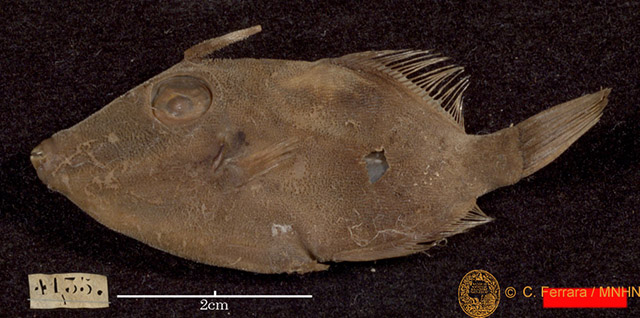| Monacanthidae (Filefishes) |
| 10 cm SL (male/unsexed) |
|
demersal; marine; depth range 10 - 50 m |
| Indian Ocean: both sides of India, and across to the western coast of Thailand. A small post-pelagic juvenile has been collected from the Maldives. |
|
Dorsal spines (total): 2-2; Dorsal soft rays (total): 26-29; Anal spines: 0-0; Anal soft rays: 27-30; Vertebrae: 19-19. Body width 1.9-2.5 in head length; body depth 2.0-2.8 in SL; head length 2.6-3.0 in SL; snout length 3.7-4.3 in SL; eye diameter 2.7-3.8 in head length. Head and body pale, with three wide, darker but rather indistinct stripes on body, first from eye to anterior half of soft dorsal base, second from above gill opening, continuing posteriorly to rear half of soft dorsal base, and third curving up from ventral flap, extending along midside of body to caudal peduncle; two prominent dark blotches separated by a pale wedge-shaped bar below anterior portion of soft dorsal fin; caudal fin with dusky basal blotch, followed by two dark curved cross bands. |
| Inhabits muddy substrates in estuaries and usually found near algae rubble reef (Ref. 48637). Also found in sand bottoms of trawling grounds in 10-50 m (Ref. 90102). |
|
Least Concern (LC); Date assessed: 18 July 2017 Ref. (130435)
|
| harmless |
Source and more info: www.fishbase.org. For personal, classroom, and other internal use only. Not for publication.

